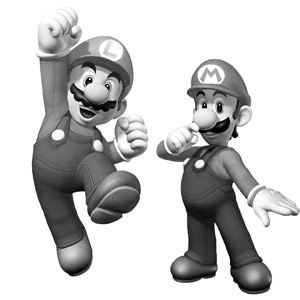Modern video games stuffed with dysfunctional characters
 CREDIT: NINTENDO
CREDIT: NINTENDOVideo game characters have all influenced our lives. Yet do some promote negative stereotypes? Do some video games make us think outside the box? Can video games promote an unhealthy lifestyle? These are all great questions. However, they really are unimportant as people will continue to play video games regardless.
Take a look at Mario and Luigi. Let's face it, as much as we all love them, they look like discarded attempts at cloning Mussolini. If the laws of physics and biology applied in real life as they did in the Mario Brothers games, then we would be totally screwed. For instance, how does a wormhole into another dimension occur in the pipe system of a home? How do two fully grown Italian men get sucked down a drain? If you look at the concept from a critical eye, the story devolves into a mash-up of bad stereotypes and poorly drawn reptiles, not to mention the drug references. In Yoshi's Island, when you consume the wrong mushroom, the screen begins flashing in psychedelic colours, and Yoshi staggers around the screen with a big dopey smile. In several of the other games, Mario and his cohorts consume flowers to shoot fire, take yellow stars to feel invincible, and eat mushrooms to grow twice as large. What does this teach children? Not to mention that while Mario is rather obese, Luigi is skinny to the point of bulimia. By any standard, drug abusers with grotesque weight problems are not a role model for anyone, especially when their only friends are make-believe dinosaurs and a woman who calls herself Princess Peach Toadstool.
The PBS documentary Raccoon Nation examines a 1970s anime series called Rascal the Raccoon. In this documentary, they explain that, during this show's popularity, thousands of children in Japan purchased raccoons and had them shipped from the U.S.A. This is because the protagonist of the series had a raccoon as a pet, and this made them very popular. Several years later, Nintendo decided to repeat the mistakes of the past with a little yellow abomination named Pikachu. Much like in the show Rascal the Raccoon, in the show Pokemon, the protagonist has a pet Pikachu, a fictional animal that he cares for and trains to attack other animals. This simple trick of repetition caused millions of children worldwide to want a Pikachu of their own and obtain one by purchasing a sad excuse for a video game. Pikachu is a small, violent creature who is abused and trained into fighting other make-believe and often ridiculous animals. Nintendo tricked millions of children and manipulated their parents into purchasing a poorly made video game with the help of a cartoon. It looks like this is a common theme for the gaming console giant.
Nintendo is not the only one making money off bad ideas and selling them as software. Take a look at Blizzard. They make the Diablo series and the World Of Warcraft massively multiplayer online roleplaying game. They also make StarCraft, but that game does not actually matter so we are not getting into it. World of Warcraft has destroyed relationships, turned friends against each other and, for some players, replaced real life with a fantasy world, not to mention the female characters portrayed in the game are sexist and unrealistic examples of women in the real world. However for the typical WoW player, making a female elf character and having her run around in a bikini is as close as they are ever gonna get, so you can't really hold that against them. My question is, how does Blizzard regard women? It appears as nothing more than objects.
Comedian Marcus Brigstock put it best when he said, "If Pacman had affected us as kids, we'd all be running around in dark rooms, munching pills and listening to repetitive electronic music." The same generation that played too much Pacman as kids ended up inventing the rave party. Since Pacman, video games have only gotten worse, while graphics, memory and console power may have increased. So have the addictive potential, lack of creativity on part of game designers, the overabundance of first-person shooters that are basically the same game only slightly remade, using female video game characters not as empowerment figures for girls but as exaggerated pieces of meat on a screen, and taking away from the productivity of people's lives. It seems that while video game graphics are getting better, the characters in those video games slowly devolve into the lowest common denominator game developers can imagine.
Editorial opinions or comments expressed in this online edition of Interrobang newspaper reflect the views of the writer and are not those of the Interrobang or the Fanshawe Student Union. The Interrobang is published weekly by the Fanshawe Student Union at 1001 Fanshawe College Blvd., P.O. Box 7005, London, Ontario, N5Y 5R6 and distributed through the Fanshawe College community. Letters to the editor are welcome. All letters are subject to editing and should be emailed. All letters must be accompanied by contact information. Letters can also be submitted online by clicking here.













